 |
Mink

Mink are related to the badger. There are two living species referred to as
"mink": the European Mink and the American Mink.
The rare European Mink is shown on the right.
All mink are dark-colored, semi-aquatic, carnivorous mammals of the family
Mustelidae, which also includes weasels, otters and ferrets. The American Mink
is larger and more adaptable than the European Mink. It is sometimes possible to
distinguish between the European and American mink; a European Mink always has a
large white patch on its upper lip, while the American species sometimes does
not. Thus, any mink without such a patch can be identified with certainty as an
American Mink, but an individual with a patch cannot be certainly identified
without looking at the skeleton. Taxonomically, both American and European Minks
used to be placed in the same genus Mustela ("Weasels"), but most recently the
American Mink has been re-classified as belonging to its own genus Neovison.
The European Mink is listed by the IUCN as Critically Endangered due to an
ongoing reduction in numbers, having been calculated as being more than 50% over
the past three generations and expected to decline at a rate exceeding 80% over
the next three generations. European mink numbers began to shrink during the
19th century, with the species rapidly becoming extinct in some parts of Central
Europe. During the 20th century, mink numbers declined all throughout their
range, the reason for which is said to be due to climate change, competition
with (as well as diseases spread by) the American mink, habitat destruction,
declines in crayfish numbers and hybridisation with the European polecat. In
Central Europe and Finland, the decline preceded the introduction of the
American mink, having likely been due to the destruction of river ecosystems,
while in Estonia, the decline seems to coincide with the spread of the American
mink.
It is similar in colour to the American mink, but is slightly smaller and has
a less specialised skull. Despite having a similar name, build and behaviour,
the European mink is not closely related to the American mink, being much closer
to the European polecat and weasel. The European mink occurs primarily by forest
streams unlikely to freeze in winter. It primarily feeds on voles, frogs, fish,
crustaceans and insects.
Historically, the American Mink's fur has been highly prized for its use in
clothing, with hunting giving way to farming. Its treatment has rightly been a
focus of animal rights and animal welfare activism. American Mink have found
their way into the wild in Europe (including Ireland and Great Britain) and
South America, after being released from mink farms by animal rights activists
or otherwise escaping from captivity.
 The
American Mink is shown on the right. The
American Mink is shown on the right.
American Mink are believed by some to have contributed to the decline of the
less hardy European Mink through competition (though not through hybridization -
European mink are closer to polecats than to their North American cousins).
Trapping is used to control or eliminate feral American Mink populations.
Mink oil is used in some medical products and cosmetics, as well as to treat,
preserve and waterproof leather.
Minks do not live in one specific spot, but are constantly on the move. They
build one shelter, stay in it for a little while, and then move somewhere else
and build another one. They do this because they are extremely territorial. A
male and female mink will live separately from one another all year, only
meeting to mate. Females generally have smaller shelters than do males. Minks
like to be surrounded by water, and will often be found living near it.
Geographically, they live in Europe and North America. |
